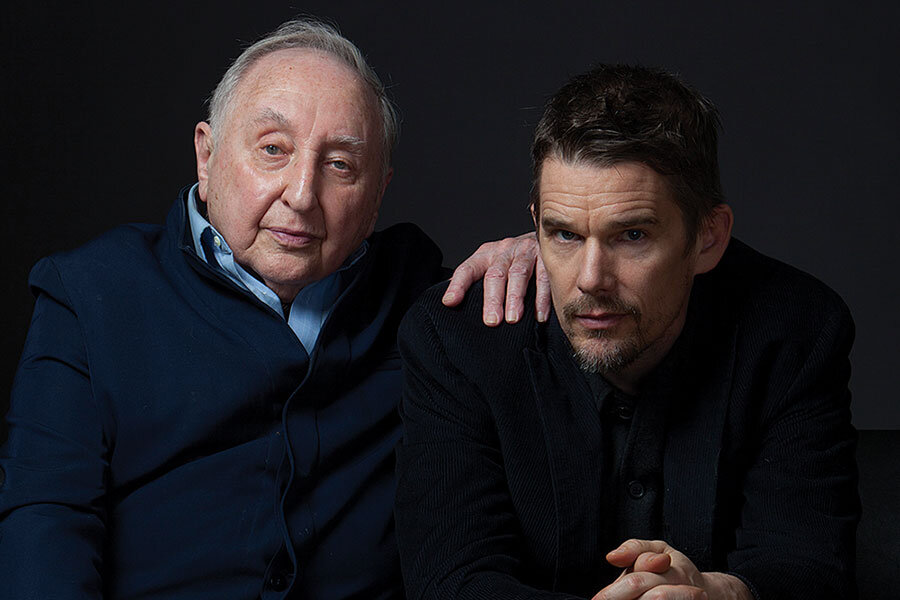'Seymour: An Introduction' masterfully conveys the sheer passion involved with great music
Loading...
Several years ago, Ethan Hawke, suffering from recurring stage fright and searching for something more authentic in his career than commercial success, attended a friend’s dinner party and was instantly captivated by one of the guests. Then in his mid-80s, Seymour Bernstein proved to be the perfect confidante: An acclaimed pianist, he gave up concertizing at age 50, largely because of stage jitters and the stress of a commercial career, and became a renowned piano teacher.
Hawke’s friendship with Bernstein led him to make a beautifully crafted documentary, his first: “Seymour: An Introduction.” I don’t believe I’ve ever seen a movie that better conveys the sheer passion both performer and listener have for great music.
From a very early age Bernstein knew that he loved music and wanted to play piano, even though his unmusical parents didn’t even own any recordings. As a little boy he heard Schubert’s “Serenade” and cried uncontrollably, believing, as he tells us, that he felt as if he “always knew that piece.” His father would tell friends, “I have three daughters and a pianist,” an insult that still stings.
Bernstein’s lessons with his prize pupils are the film’s core, but it soon becomes clear that these sessions are about much more than arpeggios and pedal technique. Certainly craft, as Bernstein attests, is essential to artistry, but what enlarges these sequences for us is how musical interpretation can become a latchkey to a more resonant life. (This film could stand as the anti-“Whiplash.”)
As a rule, I’m suspicious of artist-gurus; utilizing art as a form of life therapy all too easily lends itself to shamanistic gobbledygook. But Bernstein is a consummate musician. When he talks about how music harmonizes his life, attention must be paid. When one of his former students raises the paradox of the great artist who is also a terrible human being (Jackson Pollock and Marlon Brando are offered up as examples), Bernstein doesn’t discount the observation, but his larger point is that an artist’s truest self resides within the scope of his artistry. Beethoven chided the first listeners of his “Moonlight Sonata” for weeping, and yet it was Beethoven himself, despite his resolutely unsentimental facade, who produced such peerlessly emotional sounds.
As we thrillingly learn in the end, when Bernstein plays in public for the first time in three decades before a small audience assembled by Hawke at Steinway Hall, his powers remain undiminished. He seems transported at the keyboard – rapt beyond the reach of life’s exigencies. Those exigencies early on pushed him to control as best he could the world’s trials and changeability. (He talks about how his musicmaking encloses him in a “translucent dome.”) He says, “When Beethoven puts a B-flat down it’s there forever,” but of course, everything Bernstein does in the documentary contradicts this sentiment. As he demonstrates in his master classes at New York University, it’s how one plays that note that makes all the difference. But Bernstein is all about serving the composer’s muse. His goal as pianist and teacher is to achieve a harmoniousness with the source and allow the music to reveal its own beauty. Of Glenn Gould’s legendarily idionsyncratic interpretations of Bach, he offers this succinct bit of wisdom: “I’m not aware I’m listening to Bach. I’m listening to Glenn Gould. He’s infusing the music with his own eccentric nature.”
The film doesn’t pry into Bernstein’s private life – he’s lived alone for almost 60 years in the same Manhattan apartment – and it doesn’t point up his rather extensive career as a composer and author, either. But Hawke doesn’t shy away from highlighting the losses that might have ensued from Bernstein’s decision to quit concertizing. A friend and former pupil, New York Times writer Michael Kimmelman, asks Bernstein if gifted artists have an obligation to perpetuate their art no matter what their life circumstances. Bernstein doesn’t altogether evade the question but his answer rings true. Of his passion, he says to Kimmelman, and, by extension, to all his students: “I poured it into you.” That’s a gift, too.
For Bernstein, music is a species of religion, but with a difference. “Religion requires faith,” he says. “In music, there is the language written out for you.” The diety for Bernstein is art and it lives within him. He is so transported by music that certain pieces, such as Schumann’s Fantasie in C, Op. 17, he finds it almost impossible to practice because he just wants to keep going to the end.
The unfortunate disconnect between great artistry and great commercial success runs throughout history. But Bernstein is a special case because, unlike so many great musicians who fell unwillingly by the wayside, he chose his own path. And yet the movie, by showcasing his radiant sagacity as well as his musicianship, betrays that choice. Though he agreed to be filmed for this movie, he becomes a celebrity in spite of himself, but a celebrity of the best kind: a personification of grace. When, at the end, he plays beatifically before that assembled group, we hear his words on the soundtrack: “I never dreamt that with my own two hands I could touch the sky.” Grade: A (Rated PG for some mild thematic elements.)





